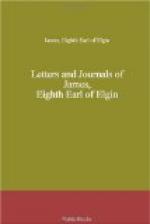Perhaps (he wrote) months of the monotony of a Calcutta existence may render the mind more sensitive to novelty and beauty; at any rate, the impressions experienced on visiting Agra at this time have been singularly vivid and keen. The surpassing beauty of the buildings, among which the Taj stands pre-eminent; the vast concourse of chiefs and retainers, combining so many of the attributes of feudal and chivalrous times with the picturesqueness in attire and gorgeousness in colouring, which only the East can supply; produced an effect of fairyland, of which it was difficult to divest oneself in order to come down to the sterner realities of the present. These realities consisted mainly in receiving the chiefs at private and public Durbars, exchanging presents and civilities with them, and returning their visits. The great Durbar was attended by a larger number of chiefs than ever before assembled on a similar occasion.’
[Sidenote: Grand Durbar.]
The Grand Durbar, or ‘Royal Court,’ was held on the morning of the 17th of February: a grander gathering, it was said, than even the great one held by Lord Canning in 1859. The scene was one of remarkable splendour—a splendour alien to the simple and unostentatious tastes and habits of the chief actor in it, but which he knew how to use with effect when taking his place as Suzerain in an Assembly of Princes. To aid us in conceiving it, we must have recourse to the picture sketched at the time in one of the Indian Newspapers.
’It is difficult to describe—without seeing it it is impossible to conceive,—a scene like that presented at a grand Durbar of this kind. One may imagine any amount of display of jewels, gold and glitter, gorgeous dresses, splendid uniforms, and handsome faces. You may see far more beautiful sights in the shape of court grandeur at our European palaces, at Versailles and St. James’s; but nothing that will give you an idea of an Indian Durbar. The exhibition of costly jewels, the display of wealth in priceless ornaments and splendid dresses, the strange mixture of wealth and poverty, the means of accomplishing magnificence and splendour enjoyed to such profusion, yet rendered almost void to this end from want of taste! “Barbaric wealth,” indeed, you behold; barbaric from its extent and profusion, and barbaric in the hideous use made of it. The host of chiefs, who sat on the right side of the huge Durbar tent, close packed in a semi-circle, and who rose as one man when the band outside began “God save the Queen,” and the artillery thundered forth the royal salute, were a blaze of jewels. From underneath head-dresses of every conceivable form and structure—the golden crown studded with rubies and emeralds, the queer butterfly-spreading Mahratta cap, the close-fitting Rajpoot turban, the common pagree of the Mohammedan Chief, ordinary in shape but made of the richest material—from under each and all there are peering dark faces, and bright glancing




